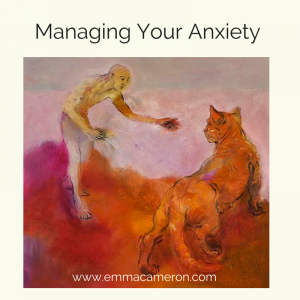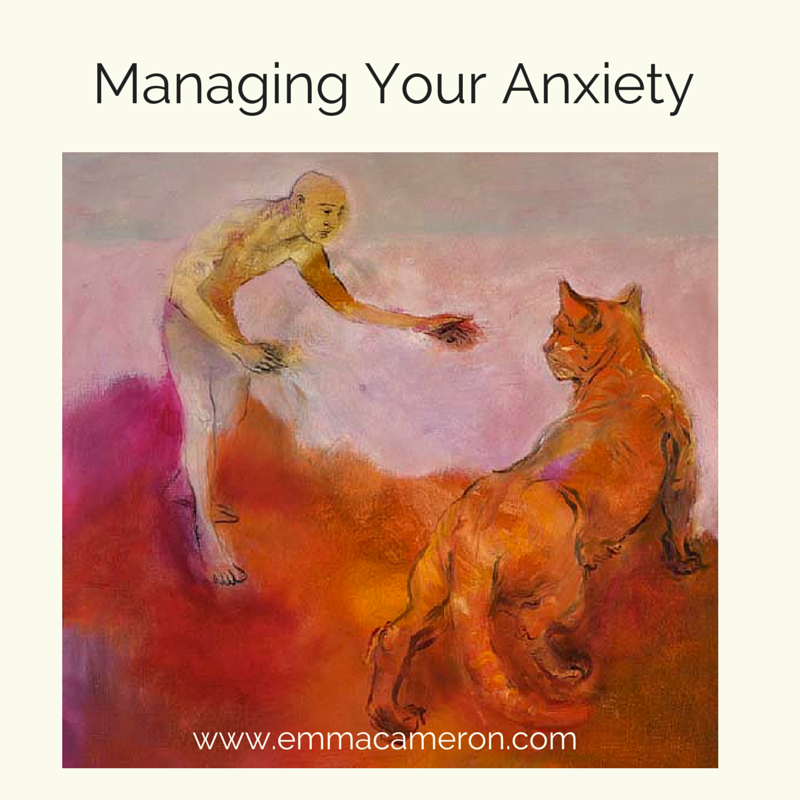Do you struggle with the symptoms of anxiety?
In order to understand what’s going on – so you can then deal with it in an effective way – it’s worth understanding something basic about the brain/body, called ‘the fight or flight* response’.
When there’s a threat to your physical safety, your body’s emergency response kicks in automatically. A part of your brain called the amygdala sends messages (“get ready to fight or run away!”) to your body super-quickly, and adrenalin and other stress hormones take over, causing all sorts of physical changes. So your heart races, muscles are pumped for action, blood leaves your extremities, your breathing gets faster and shallower, you may sweat and/or feel cold, and your face may change colour.
Do these symptoms sound familiar? If you’re someone who struggles with symptoms of anxiety, you probably experience these kinds of feelings all too often.
Anxiety is a version of the ‘fight or flight’ response.
How does that work? Well, your amygdala can’t tell the difference between a physical threat (like a bus careering towards you) and an emotional threat (like when someone you care for makes a hurtful remark to you).
And the really annoying thing is, all these physical changes can even happen with an imagined threat. Worrying about a future exam, or about your presentation at work being a disaster, could be enough to get your amygdala responding the same way as if a stray tiger had entered the room!
Luckily, there’s a way that you can help yourself calm down when your stress hormones have been triggered. Another automatic bodily response can be helped to kick in: it’s sometimes called the ‘relaxation response’. Like ‘fight or flight’, this is hardwired into the brain – so you don’t need to believe it works, it just does. When the relaxation response kicks in, neurochemicals calm your heart rate, increase relaxing brain waves, and lower your blood pressure. You feel calmer and more settled.
So how can you bring on the relaxation response?
If your body is hypersensitive to the fight or flight response (i.e. if you’ve been suffering a lot with anxiety over time), developing a reliable relaxation response will probably take quite a lot of practice.
A combination of these 8 ways may encourage the relaxation response and reduce anxiety
8 ways to foster the relaxation response and reduce anxiety Share on X1. Acceptance
Have you ever noticed that when you try and fight it off, your anxiety digs its heels in stubbornly and gets more resistant Don’t forget, it’s only been trying to keep you safe. When you remember this, and accept it, you might notice your anxiety beginning to dissolve. And even if your anxiety stays intense, just keep accepting that it’s there, without trying to change it. Importantly, don’t avoid a situation or place because you feel anxious when you’re there. Avoidance will actually make the problem worse, not better. (If you notice that you’ve been getting into habits of avoidance, do speak to your health provider about it, so that you can get support with facing up to things).
2. Notice Your Feelings
When anxiety floods us, it can be quite hard to notice any other feelings. But one of the best ways of regulating anxiety is to become aware – perhaps in a slightly detached way – of all the feelings you notice in your body. These can range from the purely physical (I have an itch on my back) to the more emotional (such as feelings around the heart and gut).
If you can, talk to someone about what you’re experiencing, as you are experiencing it. Make sure they know that they are not expected to do anything about it, or make it go away; their role is to be there by your side and listen**. Finding words for feelings – whether physical sensations or emotions – engages a part of the brain that helps with calming the fight-or-flight response. Another very helpful thing when you’re anxious can be to focus your attention on your feet and legs, really trying to notice all the sensations, from the tiniest to the broadest.
3. Movement
This is a really important one. When you exercise, those stress hormones are mopped up and used, so you can return to a more peaceful state. Do it when you’re feeling anxious – rush up and down stairs, or go for a quick jog around the block if you can. And also see if you can fit more movement into your week, generally. Walking swiftly for just half an hour, most days, can be as beneficial (or better) for your mood as antidepressants.
4. Breathing
Shallow, fast breathing makes you more anxious; slower, deeper breathing can really help to calm you. Getting your breathing to work for you and not against you is really important. Sitting calmly and upright, make your breathing slower, with the out-breath slightly longer than the in-breath, and a little pause between breaths. See if you can get it so your tummy rises and falls with each breath, but your chest doesn’t move all that much. This is a good one to practise when you’re feeling okay, so it comes easier when you’re feeling anxious. Breathing is such a basic, natural thing that many people find it hard to realise how powerful it is. But it really does have a profound effect on your physiology, and your emotions.
5. Reassurance
It’s a good idea to remind yourself that even though you may be having symptoms that can in themselves feel frightening, it’s an anxiety attack. Ask your doctor to teach you how to distinguish the symptoms of a heart attack, and those of an anxiety attack, and write this down. Keeping the information written on a card that you carry around will mean you will be in a better position to reassure yourself when necessary. Often people also fear that their anxiety symptoms may be a sign they are going mad. Again, speak to your doctor. It’s much more likely that any ‘going crazy’ feelings are a temporary symptom of anxiety.
6. Mindfulness
This has been shown to have real benefits for all sorts of difficulties associated with anxiety. You can find lots of information online, for example here: http://www.helpguide.org/harvard/benefits-of-mindfulness.htm. However, mindfulness is not entirely risk-free, so if you have had any mental health problems in the past, check with your doctor before you try meditation or mindfulness. They may suggest that you work in conjunction with a therapist or mindfulness practitioner who can help you work at a safe pace.
7. Calming Words
At a time when you are not feeling anxious, have a think about what calming words you’d ideally like to hear from someone when you are in the middle of an anxiety attack. See if you can find a form of words that feels ‘right’. Write them (or ask a loved one to write them) on a card that you can carry around, ready for reading to yourself when you feel anxious.
8. Use Your Creativity
Take a look at my article, ‘Creative Solutions for Managing Difficult Thoughts’. It’s got lots of ideas you can try, for managing when you’re feeling anxious and having repetitive thoughts and worries.
Conclusion
When you’re feeling anxious, first remind yourself of what’s going on in your brain and body. If it’s possible, practical and appropriate to do some vigorous movement, do that first (run up and down the stairs a couple of times, or go for a walk). If not, concentrate on slowing and deepening your breathing. Then add in the other techniques I’ve mentioned. You’ll get best results if you’ve also been practising in-between times, when you aren’t feeling strong anxiety, so it might be a good idea to make a plan for daily anti-anxiety practice.
Take a look at my tips for self-care, too, so that you maximise your resilience. And cut out caffeine – some people are more sensitive to caffeine than they realise, and avoiding it can make a massive difference.
I hope that you find these tips helpful. You might also like to take a look at these other articles I’ve written:
The Creative Person’s Guide to Managing Feelings
Handling Panic Attacks – 7 Simple Tools You Can Use
Panic Attacks – What No-one Tells You
Do I Worry Too Much? Take the Quiz
Your First Counselling Session – 12 Things You Need to Know
Creative Solutions for Managing Difficult Thoughts
Always check with your GP or primary care physician if you think you’ve been experiencing symptoms of anxiety. You may also get a lot of benefit from working with a psychotherapist, counsellor or Art Psychotherapist.
Counselling for anxiety symptoms can be very effective.
If you’re in the UK, look for someone who is registered with UKCP, BACP or HCPC; if you’re in another country, check the licensing regulations so that you can be sure to work with someone who is properly qualified.
I see clients for online counselling for anxiety and also face-to-face Integrative Arts Psychotherapy and counselling for anxiety in Colchester, Essex. (Currently all sessions are online due to the pandemic).
However you tackle it, I hope you find that you can develop a comfortable, effective way of managing your anxiety.
*It’s actually a bit more complex than just ‘fight or flight’, as there are a couple of other mechanisms at work, nicknamed ‘freeze’, ‘flop’ and ‘fawn’; but I’m using ‘fight or flight’ here because I’m trying to simplify things.
**If you are concerned about your health, make sure to discuss things thoroughly with a medical professional, and follow their advice.
Further reading:
https://www.hilaryjacobshendel.com/hilarys-blog
http://www.heysigmund.com/managing-anxiety/
http://drdansiegel.com/resources/
Hilary Jacobs Hendel, ‘It’s Not Always Depression’
Daniel J. Siegel, ‘Mindsight: The New Science of Personal Transformation’

